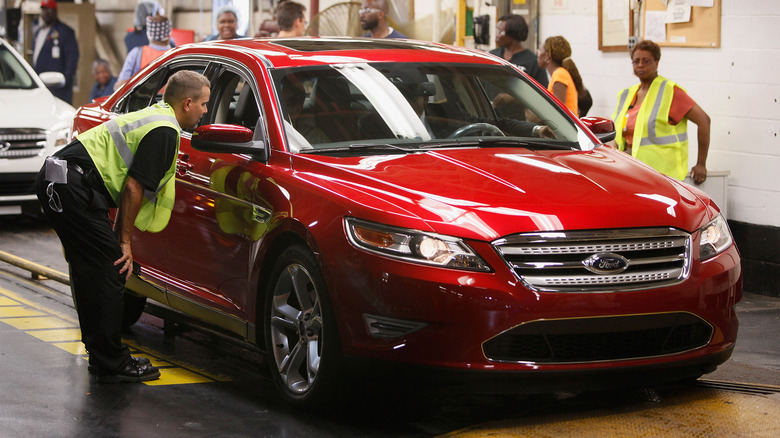Why Ford Discontinued The Taurus After Over 30 Years
The last Ford Taurus rolled off the assembly line on March 1, 2019, marking the end of an era. Once the go-to midsize five-passenger car, the Taurus was a mainstay on highways across the U.S. When it was introduced in the mid-1980s, its sleek, futuristic look broke the mold, setting it apart from its bulky American counterparts. That was ultimately the goal: when Ford began its work on the Taurus, it knew it had to do something dramatic to save the company from bankruptcy.
Saying they succeeded would be an understatement. It was named the MotorTrend Car of the Year in 1986, and made Car and Driver's "10 Best Cars" list the same year. The Taurus quickly became a household name, with drivers finding it both modern and practical. There was no stopping the Taurus, and it became one of the most popular cars of the 1990s, topping sales charts for the better part of the decade.
Six generations of the car were produced over the years, with the company assembling over 8 million at its Chicago Assembly plant during that timeframe. However, all good things must come to an end, and after a 34-year run, the Ford Taurus' time was up. Amid changing consumer preferences and the automotive industry's move towards SUVs and trucks, Ford recognized it was time to shift its focus and move on from the legendary sedan.
The end of the Ford Taurus
There wasn't a watershed moment that led to the decline of the Ford Taurus. Instead, it was the result of increased competition from Japanese midsize sedans, gradual changes in consumer preferences favoring SUVs and trucks, and Ford's decision to revamp its product lineup to focus on more in-demand vehicle categories.
With many consumers viewing Japanese sedans like the Toyota Camry and Honda Accord as more reliable and fuel-efficient cars, and others preferring the increased space, versatility, and safety provided by SUVs and trucks, the Taurus' market share began to erode. In response, Ford discontinued the Taurus in 2006, and turned its focus to other models. However, this decision was short-lived. The company changed its mind in 2008, reintroducing the Taurus as a replacement to the Ford 500 as part of a larger restructuring of its lineup.
The new Taurus was more upscale than its predecessors, targeting the premium market. In 2010, the sixth generation of the car was released, featuring a powerful engine, improved safety features, and a more modern design. While the new Taurus was well-received, it faced stiff competition in a changing market, and struggled to regain its former popularity.
Seeing the writing on the wall, Ford decided to discontinue the Taurus, along with several other sedan models including the Fiesta, Focus, and Fusion. The end of the Taurus era reflected a broader industry trend of declining sedan sales and increased dominance of SUVs and trucks in the American automotive market.

